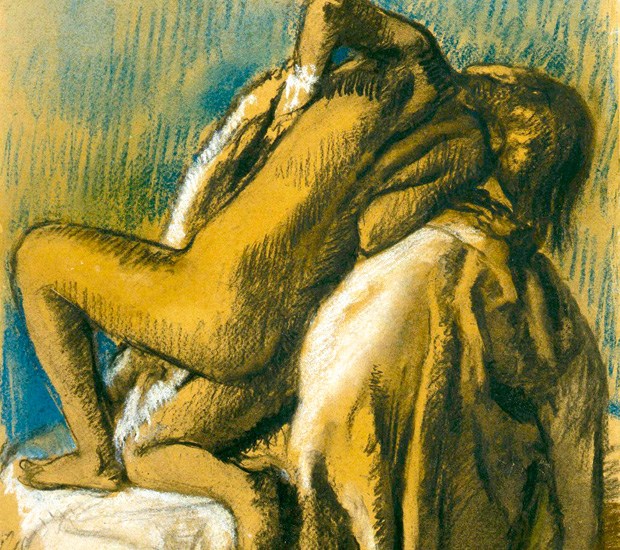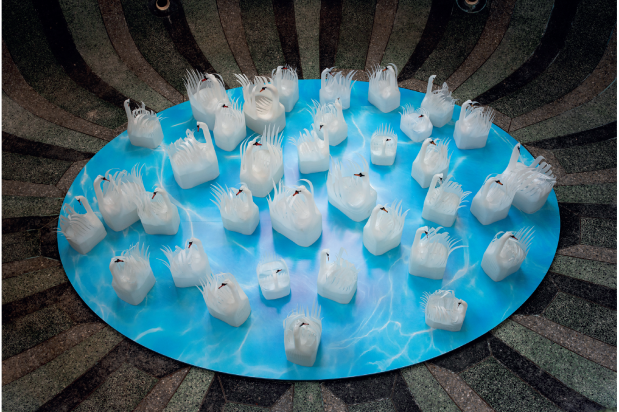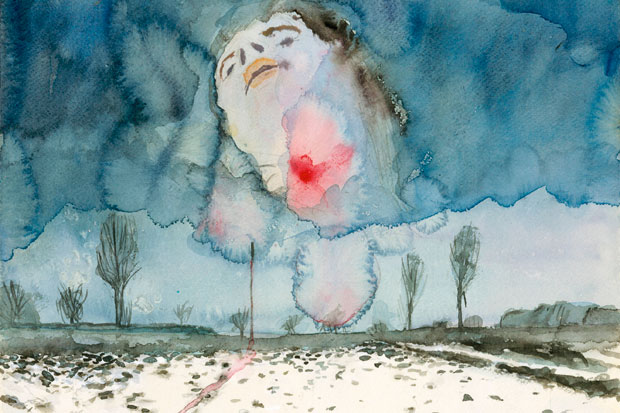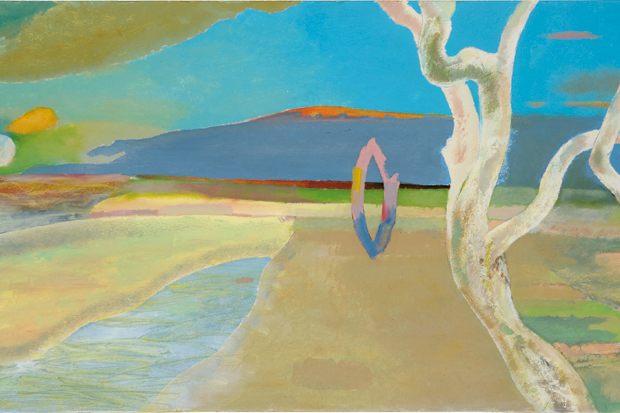As the boundary between auction house and art dealer blurs yet further, with auctioneers acting increasingly by private treaty as well as taking over commercial galleries, and as West End gallery space becomes ever more expensive, alternative exhibiting venues are being sought with growing urgency. One solution is to move further into corporate territory, and Charles Hadcock (born 1965) is currently doing just that with an exhibition of his latest sculptures in the foyer of 60 Threadneedle Street in the City. There are a number of Hadcock’s monumental organic-abstract sculptures already on permanent display in London, from Canary Wharf to Chiswick Mall (his twisting, leaping forms are among the few contemporary public sculptures that add to the aesthetic richness of our streets), and this summer his new work may be seen 24 hours a day, seven days a week, in a metropolitan location. The group of large and small sculptures in bronze and aluminium is set out to good effect in this massive, glass-fronted office foyer, carefully placed for maximum clarity of impact.
Hadcock’s originality as a sculptor lies in the very particular fusion of engineering skills, mathematical fluency and passion for music and poetry that he brings to his approach. Music is not just an inspiration and delight, its structures are echoed in his sculptural thinking, while his engineering background makes him unafraid to show how a thing is made.
Thus, often in his work engineered components are bolted together and yet the overall impression will be just as much organic as abstract. His forms relate to water turbines and seashells, rock surfaces and moulded polystyrene packaging, ammonites and fir cones. He enjoys the metaphorical as much as the literal twist, while torsion and torque are ideas fundamental to his formal vocabulary. The show features five substantial new pieces, like planets composed of interlocking spatulate fingers or spaceships of coagulated arrowheads: the fragmentary reunited in intriguing new harmonies. I particularly liked the ‘Hexad’ series, with their strong cast textures, and the white aluminium ‘Heptad’. Of the smaller works, some of the maquettes are especially beguiling, such as ‘Maquette for Hexad I’ and ‘Maquette for Caesura VIII’. With this exhibition, Hadcock confirms his place as one of the most consistently inventive of our younger sculptors.
Pastel is colour in line with an added smudginess that takes the edge off frank linearity, and thus blends intriguingly the disciplines of drawing and painting. It’s difficult to handle with more than average success, but in the hands of a skilful manipulator it offers subtle combinations of hue and directional accent that no other medium can match. Stephen Ongpin and Sophie Camu have come up with a museum-quality selection of three centuries of pastels on paper, all of which are for sale. Their extraordinary selection includes three works by Degas (two coastal landscapes and a magnificent nude, ‘After the Bath’), a very beautiful Sisley of the Gower Peninsula in Wales, Armand Point’s seductive ‘Autumn Soul’ in diaphanous tulle, an unexpectedly fiery William Rothenstein landscape, and a gorgeous Vuillard Parisian street scene. There are also good things by Avigdor Arikha (on emery paper) and Sam Szafran, Simon Bussy (including a drawing of a copperhead snake in a snakeskin frame), Kupka and Munch (another sea’s-edge subject), James Linnell (a stand of oaks) and William Degouve de Nuncques. Superb portraits by Camille Pissarro and Eva Gonzalez bring variety, and an excellent catalogue accompanies the show. Highly recommended.
At Bernard Jacobson Gallery in Cork Street (until 31 July), there’s a deeply enjoyable exhibition mostly of works on paper by Sam Francis (1923–94), the American painter who evolved a lyrical, light-filled version of Abstract Expressionism. The 1950s and 1960s works are the most exciting, employing splots and spatters and pools of pigment (ink, tempera, gouache, watercolour or acrylic) orchestrated with swift telling gestures into beautiful evocations of light and space. My old friend, the figurative painter Ken Kiff (1935–2001), thoroughly admired Francis, commenting on the ‘beautifully judged scale and movement off the surface…such sense of scale is a lot; the satisfaction is not just “decorative”.’
Further along the street, at Waddington Custot (until 12 July), is a large show of Ian Davenport’s work, to launch a magniloquent new book (Thames & Hudson, £35) on the artist, who was born in 1966. Known for his vertical stripe paintings, deliquescing into psychedelic colour swarms, varied with large horseshoe shapes and circles, Davenport pours paint with admirable dexterity. Yet the best painting here is the least formalised: ‘Satin Black on White from the Bottom to the Top’ (1989) — tricklier, subtler, altogether less definitive.
To return to sculpture, Thomas Dane has mounted an exhibition in both his Duke Street spaces to celebrate the 80th birthday of one of our most interesting (and oddly neglected) sculptors, Phillip King. King first came to prominence in the early 1960s, in the wake of the sculptural revolution led by Anthony Caro (by whom he was taught briefly at St Martins), emerging as the most original sculptor of his generation. Quite soon he seemed to be not so much Caro’s pupil as his equal in achievement, though in quite a different kind of work. He represented Britain at the Venice Biennale in 1968, the same year he enjoyed a solo show at the Whitechapel Gallery, and he has continued to make remarkable and totally unpredictable work ever since. Perhaps his determination to explore different territories of subject and material has worked against him, for his last major exhibition in a public gallery in London was at the Hayward in 1981. Public and critics alike seem to prefer an artist who can be easily recognised and pigeon-holed, and the courageously shape-shifting King has defied such branding, at considerable personal cost. His spirit of independence has kept him on the edge of the playing field, whereas his audacity and inventiveness qualify him unreservedly for a central position.
The beautiful is always bizarre, said Baudelaire, and King has a well-developed appreciation of the odd and unusual. One of his most famous sculptures is ‘Rosebud’ (1962), a large pink plastic cone with curvy petalled vertical lips revealing a smooth inner corolla of deep floaty green. It’s a sublimely sexy piece, yet beautifully formalised and contained. This sculpture stands in the entrance of 3 Duke Street, while in the background the four parts of the crazy crashed ultramarine ziggurat that is ‘Blue Blaze’ (1967) make a many-angled architectural contrast of startling intrepidity. Upstairs at 11 Duke Street, a couple of other very early sculptures in plaster and wood, ‘Drift’ (1962) and a remade version of ‘Window Piece’ (1960–1), sit happily with a new work exploring similar spatial themes and forms, ‘In and Out’ (2014), in white, pink and turquoise. In the back room, a powerful 1970s piece, ‘Sure Place’, offers a completely different take on the cone, in a kind of loose wigwam of steel and slate. Typically, Phillip King is appreciated more highly abroad than he is here. The last important show of his work I saw was in Florence at the Forte di Belvedere in 1997, and in 2013 there was a wide-ranging retrospective in Dijon. King deserves to be properly recognised in his own country. Perhaps the Tate will finally get around to doing something?
Got something to add? Join the discussion and comment below.
Get 10 issues for just $10
Subscribe to The Spectator Australia today for the next 10 magazine issues, plus full online access, for just $10.
You might disagree with half of it, but you’ll enjoy reading all of it. Try your first month for free, then just $2 a week for the remainder of your first year.














Comments
Don't miss out
Join the conversation with other Spectator Australia readers. Subscribe to leave a comment.
SUBSCRIBEAlready a subscriber? Log in